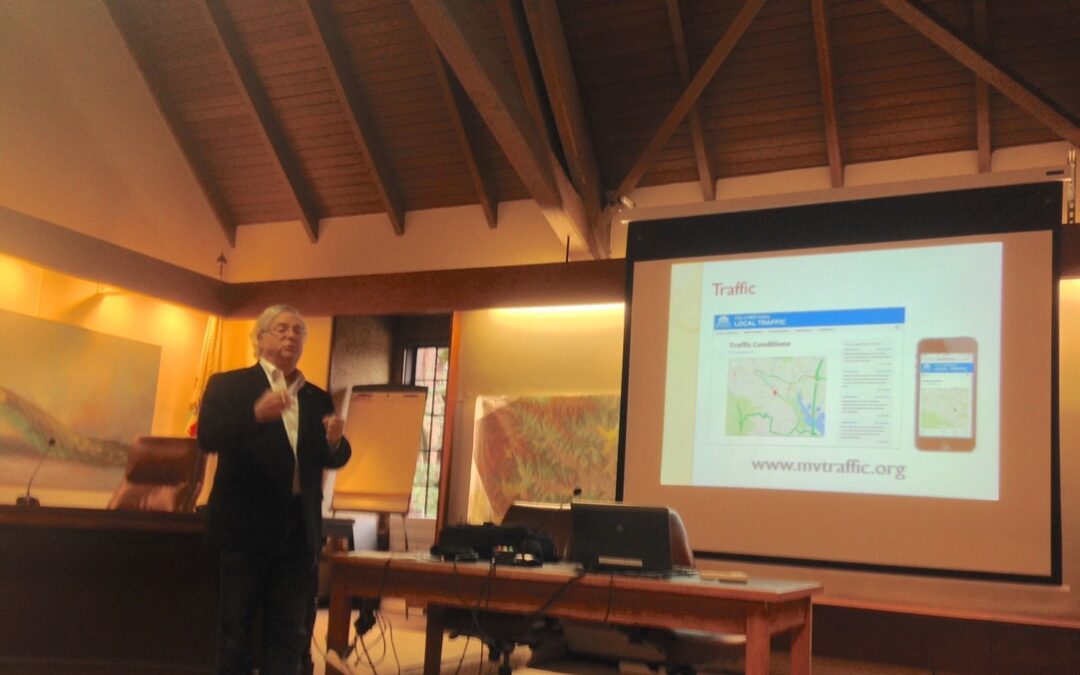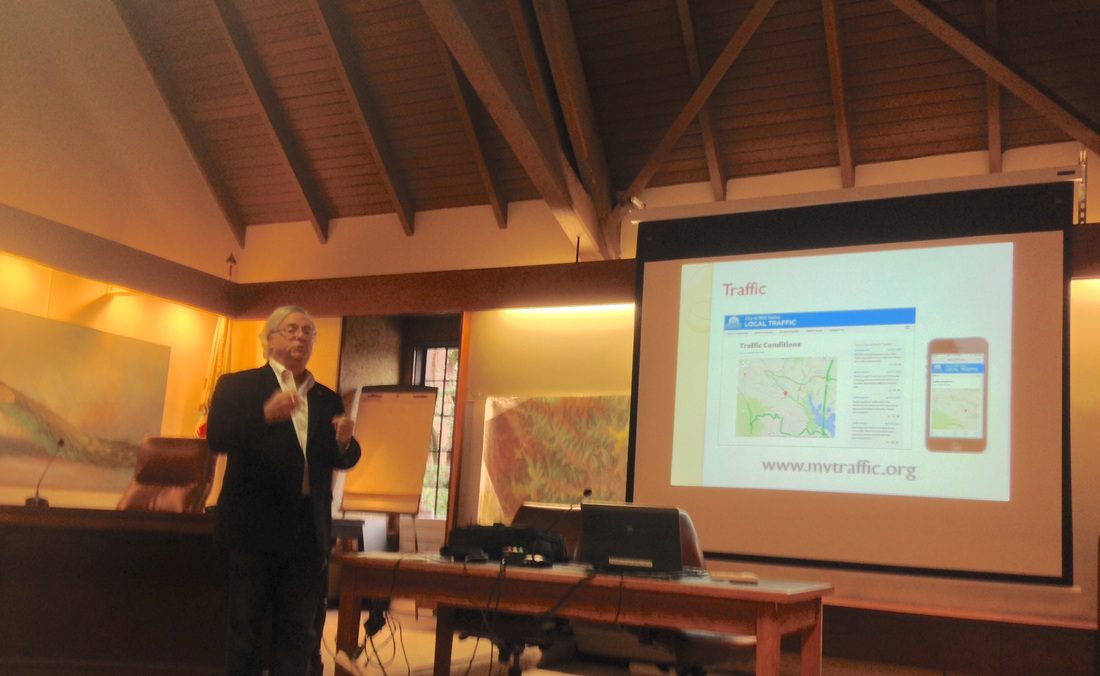|
Over the course of 90 minutes Thursday morning, Mill Valley Mayor Ken Wachtel, City Manager Jim McCann and City of Mill Valley officials took Mill Valley business owners on a wide-ranging trip through the State of the City.
The verdict: with a thriving economy and thus a construction boom and ever-congested streets, Mill Valley is bustling, and City Hall is a hive of activity. “It has been an extremely interesting, very active year for us so far,” Wachtel said. Here’s a brief summary of the topics covered, with links for more info: |
Traffic
The number one subject on everyone’s mind remains congestion on local and regional roads. Wachtel has convened a Traffic and Congestion Reduction Advisory Task Force, a group comprised of officials from the City, the Mill Valley Chamber, the County of Marin, the Mill Valley and Tamalpais Union school districts, Caltrans, the offices of State Senator Mike McGuire and State Assemblyman Marc Levine as well as two local residents. The group has held two meetings to date and largely focused on an analysis of the plethora of data that has been gathered about historical and current conditions. The data has highlighted a number of likely causes, including the number of car trips being made on the East Blithedale Ave.-Tiburon Blvd. overpass of Hwy. 101 during school commute times.
“The data reinforces what many people understand to be the nature of our traffic and will help us to focus on our options – and there are options to consider,” McCann said. “It’s all of our problem to fix this.”
Go here for a full report on the task force’s first meeting and go here for regular updates on the task force.
“The data reinforces what many people understand to be the nature of our traffic and will help us to focus on our options – and there are options to consider,” McCann said. “It’s all of our problem to fix this.”
Go here for a full report on the task force’s first meeting and go here for regular updates on the task force.
Road Repairs
At its Sept. 21 meeting, the City Council is set to make revisions to its 2015-16 budget, as the City has seen its revenues jump $1.7 million, or 4.4 percent from the budget the Council adopted in 2014. That includes projected 2015-16 property tax revenues of 15,301,103, up more than 7.5 percent since 2013-14.
In adopting the 2014-16 budget, the Council set aside additional money for road repairs, and that bore out this year with the complete repaving of the hillside section of Camino Alto and the entirety of Molino Ave., as well as eight other streets and another 18 roads that were resurfaced.
In adopting the 2014-16 budget, the Council set aside additional money for road repairs, and that bore out this year with the complete repaving of the hillside section of Camino Alto and the entirety of Molino Ave., as well as eight other streets and another 18 roads that were resurfaced.
Municipal Services Tax
The aforementioned road repairs, as well as the City’s fire prevention-focused Vegetation Management Program, are funded by the City’s Municipal Services Tax (MST). The $145 per parcel tax was first approved by voters in 1987 for 10 years, and was renewed in 1997 at $145 per parcel and 2006 at a maximum of $195 per parcel. The MST generates $1.2 million in revenue annually. Along with the $300,000 budget for the Vegetation Management Program, the MST also funds $900,000 in street maintenance and road repair. The MST is up for renewal in 2016.
Miller Avenue Streetscape Project
After years of planning, budgeting and engineering, the City of Mill Valley is set to embark in early 2016 on the Miller Avenue Streetscape Project, a complete overhaul of one of our town’s two primary arteries.
The $14.2 million project is far and away the biggest road renovation the City has undertaken in decades: an overhaul of approximately two miles of Miller Avenue, one of Mill Valley’s two main arteries. The project stretches from Almonte Boulevard near Tamalpais High all the way to Sunnyside Avenue near downtown.
Given’s the Mill Valley Chamber’s focus on minimizing the impact on businesses in the area in terms of parking and access, the Chamber and City hosted a meeting for Miller Ave. businesses in August. “It is a great concern to the City that we disrupt business as little as possible, recognizing that there will be some disruption,” Wachtel said.
This fall, utility companies such as PG&E, Marin Municipal Water District, AT&T and Comcast will conduct underground work on the road in advance of the City’s work early next year. Scheduling those utilities first will allow the City’s contractor – the project will go out to bid later this year – to move more nimbly without multiple agencies to coordinate, City officials said.
More info.
The $14.2 million project is far and away the biggest road renovation the City has undertaken in decades: an overhaul of approximately two miles of Miller Avenue, one of Mill Valley’s two main arteries. The project stretches from Almonte Boulevard near Tamalpais High all the way to Sunnyside Avenue near downtown.
Given’s the Mill Valley Chamber’s focus on minimizing the impact on businesses in the area in terms of parking and access, the Chamber and City hosted a meeting for Miller Ave. businesses in August. “It is a great concern to the City that we disrupt business as little as possible, recognizing that there will be some disruption,” Wachtel said.
This fall, utility companies such as PG&E, Marin Municipal Water District, AT&T and Comcast will conduct underground work on the road in advance of the City’s work early next year. Scheduling those utilities first will allow the City’s contractor – the project will go out to bid later this year – to move more nimbly without multiple agencies to coordinate, City officials said.
More info.
Parking
Acting on recommendations from the City’s Parking Enforcement Advisory Committee, the City changed 14 metered parking spaces in the City Hall parking lot from a two-hour to a one-hour time limit in an effort to provide more parking for shoppers. (Download the report and recommendations).
This change is intended to make the downtown parking system friendlier to its diverse array of user groups, such as residents doing some quick grocery shopping, banking or other downtown errands. The City also hopes to extend the time limit on the metered parking spaces in the parking lot on the first block of Miller Avenue, where Piazza D’Angelo and Wells Fargo are located, for instance, from two to four hours, but has met some technological hurdles in doing so to date.
This change is intended to make the downtown parking system friendlier to its diverse array of user groups, such as residents doing some quick grocery shopping, banking or other downtown errands. The City also hopes to extend the time limit on the metered parking spaces in the parking lot on the first block of Miller Avenue, where Piazza D’Angelo and Wells Fargo are located, for instance, from two to four hours, but has met some technological hurdles in doing so to date.
Downtown Restroom
In February, the Council approved a recommendation to build a new downtown public restroom in the location adjacent to the Depot Building. Since then, the City has been in the midst of architectural design and the development of a proposed timeline and budget. City officials allocated $150,000 in the 2014-15 budget and have proposed to set aside an additional $350,000 in the 2015-16 budget for the project, with the design and final cost estimate returning the Council later this year.
Planning & Building
Planning & Building Director Vin Smith informed attendees that his department has mostly eliminated “plan checks” by outside parties, hoping to streamline the permit process by internal restructuring that allows most of those evaluations to be done in-house.
Smith said his department tries to get commercial permit requests on the Planning Commission’s agenda “as quickly as possible,” particularly given the bevy of residential permit applications they receive. He also said the department sought to accommodate commercial applicants when possible, citing a recent example in which his department gave a new business approval to do interior improvements to a new space downtown while the applicant sought City approval for exterior changes.
Several business owners indicated that the City could do more to make it easier for permit applicants to contact the right person during the process, and McCann urged business owners to reach out to the Chamber to assist with those efforts.
Smith said his department tries to get commercial permit requests on the Planning Commission’s agenda “as quickly as possible,” particularly given the bevy of residential permit applications they receive. He also said the department sought to accommodate commercial applicants when possible, citing a recent example in which his department gave a new business approval to do interior improvements to a new space downtown while the applicant sought City approval for exterior changes.
Several business owners indicated that the City could do more to make it easier for permit applicants to contact the right person during the process, and McCann urged business owners to reach out to the Chamber to assist with those efforts.
Development Standards and Design Guidelines
The City remains in the midst of a lengthy process to change its Multi-Family Residential Development Standards and create new design guidelines for multi-family and mixed-use development projects, and the Council affirmed the City’s course on that effort earlier this month. The expanded review process is largely an effort to address concerns from residents of the “Downtown Multi-Family Residential” area that includes Downtown and its immediately peripheral streets.
“The goal of this is to give some predictability to what these projects should look like and what is possible,” Wachtel said.
Smith added that while updates to the Commercial Zoning regulations are on the to-do list, that effort will likely take place in 2016.
More info.
“The goal of this is to give some predictability to what these projects should look like and what is possible,” Wachtel said.
Smith added that while updates to the Commercial Zoning regulations are on the to-do list, that effort will likely take place in 2016.
More info.
Want to know what’s happening around town? Click here to subscribe to the Enjoy Mill Valley Blog by Email!


